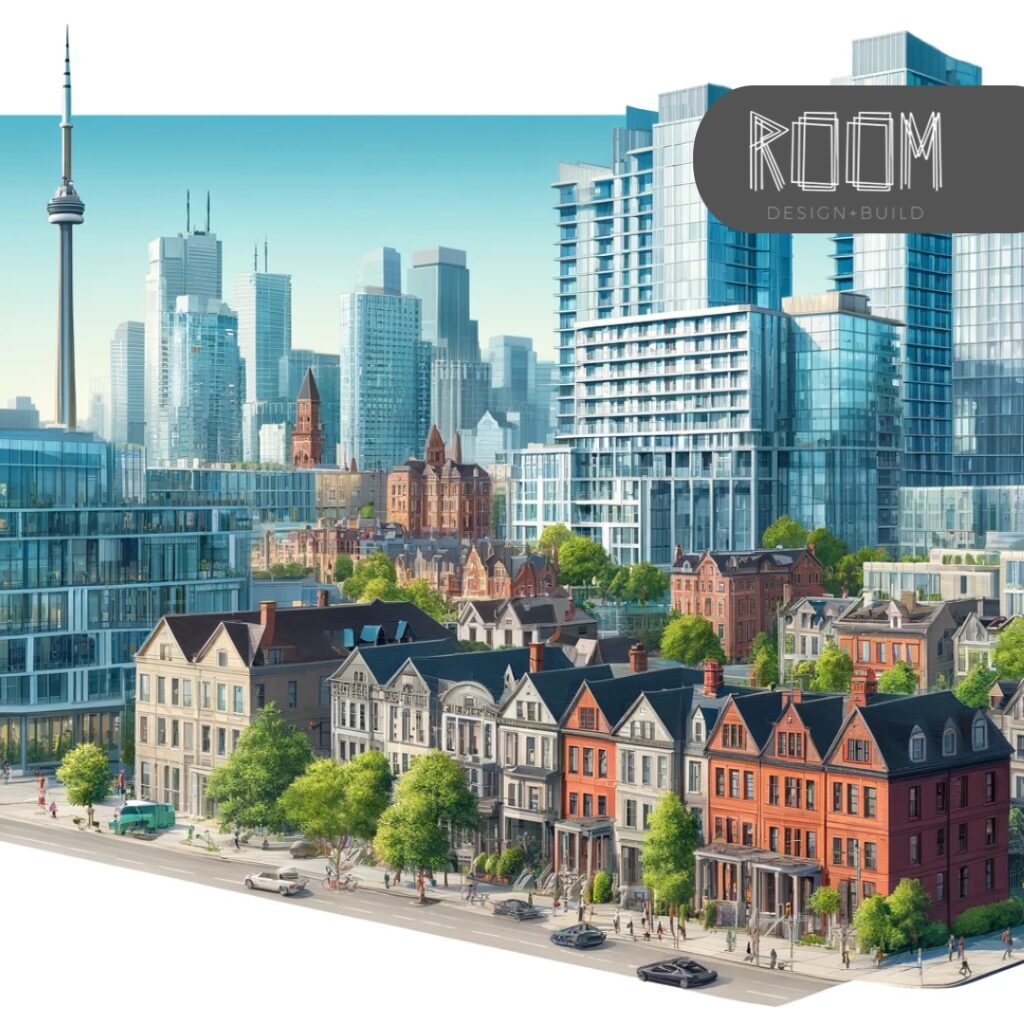Table of Contents
As of March 31, 2024, Toronto has implemented a critical update to the regulatory framework governing multi-tenant houses. This significant change affects both operators and tenants by introducing new licensing requirements that aim to enhance the management and safety of these housing options. This comprehensive guide will detail these new requirements, delineate the responsibilities now placed on house operators, and discuss the broader impact of these changes on both the construction and real estate sectors. Our goal is to provide a clear understanding of the changes to help operators comply with the new standards and ensure tenants receive adequate protections and services.
What is a Multi-Tenant House?

In Toronto, a multi-tenant house, also commonly referred to as a rooming house, is a type of residential accommodation where four or more rooms are rented out individually. Each tenant has their own private bedroom but shares essential facilities such as kitchens and bathrooms with other tenants. This housing arrangement does not constitute a single housekeeping unit, differing fundamentally from more traditional rental units where entire apartments or homes are leased.
This housing model is particularly vital in dense urban areas where affordable housing options are scarce. By offering a cost-effective
alternative, multi-tenant houses help to alleviate some of the challenges associated with urban living. They provide essential accommodation for
students, low-income individuals, and new residents who may find other types of housing unaffordable. As such, they play a crucial role in the broader strategy to address urban housing shortages, making them an integral part of Toronto’s approach to inclusive urban development.
The Role of Multi-Tenant Houses in Urban Housing

Multi-tenant houses are crucial in cities like Toronto, where real estate prices are exceptionally high. These residences provide flexible, lower-cost housing alternatives that are indispensable for accommodating a diverse urban population. By offering individual rooms for rent with shared facilities, multi-tenant houses enable affordable living in central locations.
Such housing solutions cater particularly to students, low-income earners, and new immigrants who might otherwise struggle to afford private accommodations. Multi-tenant houses not only help in mitigating the housing affordability crisis but also foster a sense of community among residents from varied backgrounds, contributing to the social fabric of the city.
New Licensing Requirements
Overview of Licensing Changes
The new framework mandates that all operators of multi-tenant houses in Toronto must obtain a license. This move aims to standardize living conditions across these properties and ensure safety and compliance with city regulations.
Types of Licenses
There are two main types of licenses under the new regulations:
- Type A License: Standard multi-tenant housing.
- Type B License: Multi-tenant housing providing personal care and meals.
Steps to Obtain a License
Operators must follow these steps to secure a license:
- Zoning Review: Ensure the property meets residential zoning requirements.
- Submission of Plans: Include floor plans, fire safety plans, and property management plans.
- Inspection: The property will be inspected by city officials to ensure compliance with the building, fire, and electrical safety codes.
Operator Responsibilities and Compliance
Operators of multi-tenant houses are entrusted with upholding high safety and hygiene standards crucial for tenant welfare. They are required to ensure regular pest control to maintain a healthy living environment, manage waste efficiently to avoid sanitation issues, and keep the property in good repair to ensure safety and comfort for all residents.
Emergency Preparedness
To ensure tenant safety in emergencies, operators must designate an accessible emergency contact available 24/7. Additionally, a clearly outlined fire safety plan must be posted in a prominent location within the property, detailing evacuation routes and emergency procedures to ensure everyone knows how to react in case of a fire.
Compliance with Codes
Compliance with regulatory codes is mandatory for maintaining the operational license of a multi-tenant house. Operators must strictly adhere to the Ontario Building Code, ensuring the structural integrity and safety of the building. They must also follow the Ontario Fire Code, which includes maintaining all fire safety measures and equipment. Compliance with the Ontario Electrical Safety Code is equally critical to prevent electrical hazards and ensure the electrical systems are up to standard. Together, these regulations help ensure the safety and security of the tenants and the property.
Benefits of the New Regulatory Framework

Improved Safety
The introduction of standardized licensing requirements under the new regulatory framework significantly enhances tenant safety across Toronto’s multi-tenant houses. By enforcing strict compliance with the Ontario Building, Fire, and Electrical Safety Codes, the framework actively reduces the risk of fire hazards and other safety issues, ensuring that living conditions are secure and well-regulated. This proactive approach aims not only to protect the physical safety of tenants but also to provide a more secure living environment for all.
Enhanced Quality of Living
The regulation of operations under the new framework means that tenants will benefit from consistently maintained living spaces. With operators now held to higher standards of property upkeep, including regular pest control, efficient waste management, and ongoing property repairs, tenants are assured of living in environments that are not only safer but also more comfortable and appealing. This commitment to maintaining high standards contributes significantly to the overall well-being and satisfaction of tenants, promoting a better quality of life within these communities.
Challenges and How to Overcome Them
Navigating New Regulations
For newcomers to the multi-tenant housing market, the slew of new regulations can be overwhelming. It is crucial for these operators to seek guidance from legal and real estate experts who can provide clarity and assistance in understanding and implementing the detailed requirements of the new licensing framework.
Financial Implications
Meeting the new standards can incur significant initial costs. Operators must carefully manage their finances and explore options such as grants or loans specifically designed to help small businesses or real estate operators meet regulatory compliance. This financial planning will be essential in smoothing the transition and sustaining operations under the new regulatory regime.
Summary

The introduction of new licensing requirements for multi-tenant houses in Toronto marks a pivotal moment in the city’s approach to residential housing. This regulatory shift is aimed at enhancing the safety and living standards for tenants in rooming houses across the city. While the new rules bring about a more structured and regulated environment, they also promise significant long-term benefits for both tenants and operators.
For operators, although the transition involves navigating through a series of new regulations and possibly incurring initial costs, the payoff comes in the form of higher standards of operation and potentially increased property values. For tenants, the stricter regulations ensure safer, better-maintained living environments, contributing significantly to their overall quality of life.
Furthermore, these changes reflect a broader commitment by city authorities to improve housing conditions and address the needs of a diverse tenant population. By fostering safer and more reliable housing options, Toronto is setting a standard that could potentially influence housing policies in other cities.
Ultimately, the new licensing requirements are not just about adhering to laws; they are about fostering a safer, more vibrant community where every resident can thrive. As these changes are implemented, it will be important for all stakeholders to continue collaborating, sharing feedback, and working together to refine and optimize the regulatory framework to best serve the city’s needs.
References
- City of Toronto: Multi-Tenant Houses Licensing Guide
- Ontario Building Code
- Ontario Fire Code
- Toronto Fire Services
How We Can Help
Room Design Build is an architectural design and build firm located in Toronto. If you need more information on design and build, contact us today and learn how we can help you.
The information provided above is of a general nature and should not be considered as advice. Each transaction or situation is unique and requires specific advice to meet your specific needs. Therefore, if you have questions about residential and commercial construction, consulting with an expert in the field is recommended.



